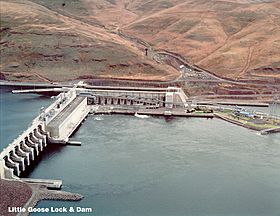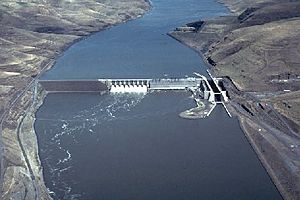Little Goose Dam facts for kids
Quick facts for kids Little Goose Dam |
|
|---|---|

From the north side of the Snake River
|
|
| Location | Columbia / Whitman counties, Washington, USA |
| Coordinates | 46°35′15″N 118°01′34″W / 46.5873693°N 118.0260593°W |
| Construction began | June 1963 |
| Opening date | 1970 |
| Operator(s) | U.S. Army Corps of Engineers |
| Dam and spillways | |
| Type of dam | Concrete-gravity, run-of-the-river |
| Height | 98 ft (30 m) |
| Length | 2,655 ft (809 m) |
| Elevation at crest | 643 ft (196 m) above sea level |
| Spillway type | Service, gate-controlled |
| Reservoir | |
| Creates | Lake Bryan |
| Total capacity | 516,300 acre⋅ft (0.6368 km3) |
| Surface area | 10,025 acres (40.57 km2) |
| Power station | |
| Turbines | 6 x 135–153 MW (181,000–205,000 hp) units |
| Installed capacity | 932 MW (1,250,000 hp) |
The Little Goose Lock and Dam is a large structure built on the Snake River in Washington, USA. It's located in Columbia and Whitman counties. This dam helps create electricity and allows boats to travel along the river. It's about 9 miles (14 km) northeast of Starbuck.
Contents
Little Goose Dam: Powering the Northwest
The Little Goose Dam is a special type of dam called a "run-of-the-river" dam. This means it uses the natural flow of the river to make power, rather than storing huge amounts of water. It's made of concrete and helps manage the river for different uses.
Building the Dam
Work on the Little Goose Dam started in June 1963. It was built on an area known as Little Goose Island. The main parts of the dam and its first three power generators were finished by 1970. Later, three more generators were added in 1978.
How Much Power Does It Make?
The dam can produce a lot of electricity. Its normal power output is 810 megawatts (MW). When needed, it can even generate up to 932 MW. This power is sent to homes and businesses in the region.
The Spillway
The dam has a part called a spillway. This is where extra water can flow over or through the dam. The spillway at Little Goose Dam is 512 feet (156 meters) long and has eight gates. These gates can be opened or closed to control the water flow.
Part of a Bigger System
The Little Goose Dam is not alone. It's one of many dams that are part of the larger Columbia River Basin system. This system of dams works together to manage water, produce electricity, and help with river navigation across a huge area.
The Lake Behind the Dam
Behind the Little Goose Dam, a lake forms called Lake Bryan. This lake was named after Doctor Enoch A. Bryan. Lake Bryan stretches for 37 miles (60 km) upstream, all the way to the base of another dam called Lower Granite Dam. Downstream from Little Goose Dam, the river flows into Lake Herbert G. West, which is formed by the Lower Monumental Dam. This lake extends about 28 miles (45 km).
Moving Boats and Fish
The dam has special features to help with river travel and to protect fish.
To allow boats to pass the dam, there is a navigation lock. This is like a water elevator for boats.
- It is a single-lift lock, meaning boats go up or down in one step.
- The lock is 86 feet (26 meters) wide.
- It is 668 feet (204 meters) long.
Fish Ladder
Dams can block fish from swimming upstream to lay their eggs. To help fish like salmon and steelhead, the Little Goose Dam has a special "fish ladder." This is a series of pools and steps that fish can jump through to get around the dam and continue their journey.


